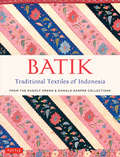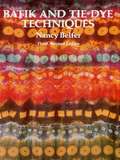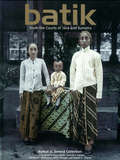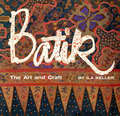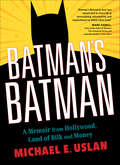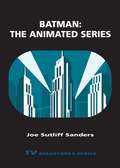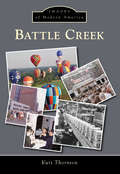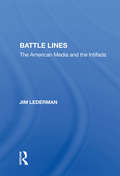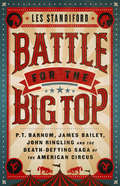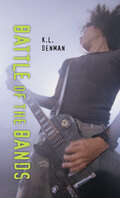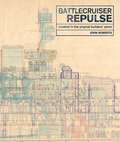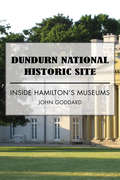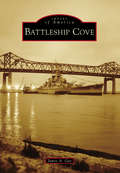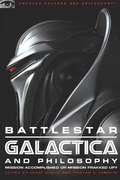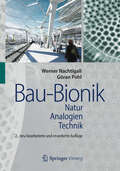- Table View
- List View
Batik Traditional Textiles of Indonesia: From The Rudolf Smend & Donald Harper Collections
by Rudolf Galerie SmendThe extraordinary textiles in this book are from the collections of Rudolf Smend and Donald Harper. Most date from the period 1880 to 1930 when the art of batik reached its apogee. Having collected historic batik for over thirty years and published two books on the subject, Rudolf Smend has invited his friend and fellow batik specialist Donald Harper to contribute his fine collection to this publication as well.<P><P> None of the batik in this book have been published before. They represent an exquisite cross-section of the batik production of Java—the most important batik-producing region in the world. <P> The cloths are complemented by vintage photographs from the first quarter of the 20th century demonstrating how the batik were worn at court and at home. Three are from museums in Dresden and Cologne, while three are from the private collection of Leo Haks. The others have been collected over the past 30 years from private sources in Java. The captions are by Maria Wronska-Friend, an ethnologist and batik expert who frequently visits Indonesian batik centers and has worked for many years as an anthropologist in Papua New Guinea. Her contributions provide fundamental knowledge for lovers of this art form while at the same time providing new insights for experts. <P> Rudolf Smend has invited other batik aficionados of his generation to share their passion for batik in this book. Inger McCabe Elliott, author of the bestselling Batik: Fabled Cloth of Java has contributed her lifelong experience. Other authorities like Annegret Haake, Brigitte Khan Majlis and Jonathan Hope share their views and expertise in these pages. This book represents a labor of love and a lifetime of friendship for the two authors, who hope it will provide inspiration to a whole new generation of batik lovers.
Batik and Tie Dye Techniques
by Nancy BelferIn this comprehensive, generously illustrated handbook, textile artist and teacher Nancy Belfer leads readers step by step through the technique required to successfully create imaginative and beautiful batiks and tie-dyed textiles. Even beginners, following the instructions in this thorough, thoughtful guidebook, can create colorful and exciting textiles that will add distinctive touches to clothing, home furnishings, and more.The author first reviews the early uses of dyes and the application of resist dye processes to textiles, then explores the history and tradition of batik, emphasizing the traditional Javanese batik method. She then covers every facet of the process of designing and making batiks, from selecting proper equipment and supplies, setting up a studio and making preliminary drawings and sketches to preparing the wax, applying the wax to cloth, applying dyes, and setting color.Ms. Belfer follows a similar format in reviewing the history and traditions of tie dye and the art of designing with tie resist techniques, clearly demonstrating each stage of the process, including tritik, clamping, and discharge methods. Over 100 photographs and 28 diagrams make it easy to follow the various procedures. A helpful list of materials and equipment suppliers rounds out this excellent guide.
Batik: From The Rudolf Smend & Donald Harper Collections
by Rudolf Smend Donald HarperBatik occupies a special place in Indonesian culture. Each fabric has a rich story to tell-as a reflection of the nation's religious beliefs, sophisticated court cultures and cosmopolitan history.The extraordinary textiles in this book are from the collections of Rudolf Smend and Donald Harper. Most date from the period 1880 to 1930 when the art of batik reached its apogee. Having collected historic batik for over thirty years and published two books on the subject, Rudolf Smend has invited his friend and fellow batik specialist Donald Harper to contribute his fine collection to this publication as well. None of the batik in this book have been published before. They represent an exquisite cross-section of the batik production of Java-the most important batik-producing region in the world.The cloths are complemented by vintage photographs from the first quarter of the 20th century demonstrating how the batik were worn at court and at home. Three are from museums in Dresden and Cologne, while three are from the private collection of Leo Haks. The others have been collected over the past 30 years from private sources in Java. The captions are by Maria Wronska-Friend, an ethnologist and batik expert who frequently visits Indonesian batik centers and has worked for many years as an anthropologist in Papua New Guinea. Her contributions provide fundamental knowledge for lovers of this art form while at the same time providing new insights for experts.Rudolf Smend has invited other batik aficionados of his generation to share their passion for batik in this book. Inger McCabe Elliott, author of the bestselling Batik: Fabled Cloth of Java has contributed her lifelong experience. Other authorities like Annegret Haake, Brigitte Khan Majlis and Jonathan Hope share their views and expertise in these pages. This book represents a labor of love and a lifetime of friendship for the two authors, who hope it will provide inspiration to a whole new generation of batik lovers.
Batik: From the Courts of Java and Sumatra
by Rudolf G. Smend Leo Hanks Harmen C. Veldhuisen Brigitte Khan Majlis Peter WengerBatik occupies a special position in Indonesia's history and culture. The extraordinary photographs of cloths and prints in this book demonstrate why batik is the stuff of textile legend. These 71 batik designs, taken from the collection of famed dealer Rudolf G. Smend, date from 1880-1930, a time still considered batik's golden age. Complementing these extraordinary cloths are 16 vintage photo prints from the Leo Haks collection, which demonstrate how batik was worn at court and in other settings.
Batik: From the Courts of Java and Sumatra
by Rudolf G. Smend Leo Hanks Harmen C. Veldhuisen Brigitte Khan Majlis Peter WengerBatik occupies a special position in Indonesia's history and culture. The extraordinary photographs of cloths and prints in this book demonstrate why batik is the stuff of textile legend. These 71 batik designs, taken from the collection of famed dealer Rudolf G. Smend, date from 1880-1930, a time still considered batik's golden age. Complementing these extraordinary cloths are 16 vintage photo prints from the Leo Haks collection, which demonstrate how batik was worn at court and in other settings.
Batik: The Art and Craft
by Ila KellerHere in this volume the author has not only given a comprehensive and fascinating account of the origins and history of batik, with examples of techniques and design, but also includes a complete "How-To-Do-It" section on modern methods of creating batik. The text is lucid and easy to follow, and the simple step-by-step format will enable the art enthusiast to investigate this rewarding and creative medium. Sample batiks by modern artists, show what can be done with craft, skill, and imagination. The author takes the reader through all aspects of making a batik, from a simple dipping, or tie-dying, to sectional dyeing, and the more intricate five or six-color patterns. Basic materials, fabric mixtures, wax temperatures etc. are discussed fully, and more important, the practical problems often encountered by a beginner are thoughtfully explained. Here is a book of batik literally giving you the 'tricks of the trade'.
Batman's Batman: A Memoir from Hollywood, Land of Bilk and Money
by Michael E. UslanAn insider's look at Hollywood and how movies and television shows are made.In Batman's Batman, Michael E. Uslan, executive producer of the Batman movie franchise, offers an insider's look at Hollywood and the process of how movies and television shows go from the drawing board to your screens.Continuing the delightful tale of his adventures begun in The Boy Who Loved Batman, Uslan draws on both his successful and less successful attempts to bring ideas to the screen, offering a helpful, honest, and breezily told guide to producing films. From passion to promotion, from the initial pitch to selecting the best partners and packaging, Uslan reveals the 13 qualities essential to would-be producers. A lively memoir and a valuable glimpse inside Hollywood rarely seen by the public, Batman's Batman is sure to please fans of Michael Uslan and the Batman franchise, but will also prove to be an invaluable resource for any aspiring producers, as he guides readers through the Land of Bilk and Money.
Batman: Batman
by Matt YockeyABC's action-comedy series Batman (1966-68) famously offered a dual address in its wildly popular portayal of a comic book hero in a live action format. Children uncritically accepted the show's plots and characters, who were guided by lofty ideals and social values, while adults reacted to the clear parody of the values on display. In Batman, author Matt Yockey argues that the series served as a safe space for viewers to engage with changing attitudes about consumerism, politics, the Vietnam war, celebrity, race, and gender during a period when social meaning was increasingly contested in America. Yockey examines Batman's boundary pushing in four chapters. In "Bat-Civics," he analyzes the superhero as a conflicted symbol of American identity and considers the ways in which the Batman character parodied that status. Yockey then looks at the show's experimentation with the superhero genre's conservative gender and racial politics in "Bat-Difference" and investigates the significance of the show's choices of stars and guest stars in "Bat-Casting." Finally, he considers how the series' dual identity as straightforward crime serial and subversive mass culture text set it up for extratextual production in "Bat-Being." The superhero is a conflicted symbol of American identity--representing both excessive individualism and the status quo--making it an especially useful figure for the kind of cultural work that Batman undertook. Batman fans, from popular culture enthusiasts to television history scholars, will enjoy this volume.
Batman: The Animated Series (TV Milestones Series)
by Professor Joe Sutliff SandersIt’s possible that no other version of Batman has been more influential than the one that debuted as a children’s cartoon in 1992. For millions of fans around the world, the voices of Batman and the Joker introduced in Batman: The Animated Series (BTAS) remain the default. The characters, designs, and major themes of the show went on to shape other cartoons, films, and bestselling video games. In this study, Joe Sutliff Sanders argues that BTAS is not only a milestone of television but a milestone in the public persona of one of the most recognizable characters in the world. The series introduced a new generation to Batman and provided the foundation for a family of cartoons that expanded the superhero universe. It introduced or reinvented major characters including Mr. Freeze, Robin, the Joker, and Harley Quinn. In three chapters, Sanders pursues the intricate arguments that still energize BTAS. Chapter 1 explores the visuals of the show, the artistic histories and tensions that inform its revolutionary style, and what ideas—intentional and otherwise—its aesthetic implies. Chapter 2 turns to the task of defining a "good" wealthy person against a backdrop of "bad," getting to the heart of one of Batman’s most problematic characteristics. Lastly, chapter 3 considers Harley Quinn, a character who emblemizes much of what made BTAS successful. From her first appearance, Harley has been both sexy and witty, victor and victim, and this chapter explains the duality that defines her. Since its debut in 1992, BTAS has garnered multiple awards, launched or developed the careers of countless important artists, and created aesthetic styles—in terms of both visuals and voice acting—that continue to resonate. Sanders’s book follows an informative and exciting path through the material and is designed to be accessible to aficionados as well as relative newcomers. Batman fans, popular culture enthusiasts, and media studies scholars will find within these pages insights and ironies to provoke endless conversations.
Baton Rouge
by Sylvia Frank Rodrigue Faye PhillipsIn 1699, on a high bluff along the Mississippi River, explorer Pierre Le Moyne, Sieur d'Iberville, found the fabled "Red Stick," a post that marked the line between two Native American nations and gave Baton Rouge, Louisiana, its name. This book chronicles 150 years of the daily activities of Baton Rouge's residents through images of the city's growth and development; life during the Civil War, floods, hurricanes, and economic depressions; and people working, playing, and celebrating.
Battery Park City: Politics and Planning on the New York Waterfront (Cities And Regions Ser. #Vol. 1)
by David L. GordonBattery Park City in Manhattan has been hailed as a triumph of urban design, and is considered to be one of the success stories of American urban redevelopment planning. The flood of praise for its design, however, can obscure the many lessons from the long struggle to develop the project. Nothing was built on the site for more than a decade after the first master plan was approved, and the redevelopment agency flirted with bankruptcy in 1979.Taking a practice-oriented approach, the book examines the role of planning and development agencies in implementing urban waterfront redevelopment. It focuses upon the experience of the central actor - the Battery Park City Authority (BPCA) - and includes personal interviews with executives of the BPCA, former New York mayors John Lindsay and Ed Koch, key public officials, planners, and developers. Describing the political, financial, planning, and implementation issues faced by public agencies and private developers from 1962 to 1993, it is both a case study and history of one of the most ambitious examples of urban waterfront redevelopment.
Battle Creek (Images of Modern America)
by Kurt ThorntonIn 1825, two government surveyors platting the southwest Michigan territory engaged in a small skirmish with two Native Americans. With a humorous nod, the surveyors gave the name Battle Creek to the river where this encounter took place. A few years later, a group of entrepreneurs, led by Sands McCamly, established a milling community and named it after the river. Thus the city of Battle Creek had its start. Over the following 170 years, it has grown into a thriving community of culture and character. This book uses historical photos and rare illustrations to trace Battle Creek's chronological development, from its water-powered mills, its railroads and factories, and its identity as a major stop on the Underground Railroad to its eventual pre-eminence as the "Cereal City."
Battle Creek (Postcard History Series)
by Kurt Thornton Carol BennettFounded in 1831, Battle Creek has transformed itself with a rapidly changing world-from agrarian milling community to manufacturing center to the current morph into a food health research center. For 100 years, "Cereal City" has been connected to ready-to-eat breakfast foods, home to the Post Division of General Foods, Ralston Foods, and the Kellogg Company, making it the largest cereal-producing city in the world. Visitors and residents alike have enjoyed mailing postcards of this dynamic community to friends and family all over the world.
Battle Lines: The American Media And The Intifada
by Jim LedermanThis book is about the intifada, the popular Palestinian uprising in the Israeli-occupied territories, broadcasted by television to an audience of millions. It explores what happens in a democracy when a government faces a major political crisis with potentially damaging international implications.
Battle Pass Success for Fortniters: An Unofficial Guide to Battle Royale (Master Combat #6)
by Jason RichTime to upgrade to your game and get rewards with Achieve Battle Pass Success! If you didn’t think Fortnite could get any more exciting, think again. Devoted Fortnite gamers can now score incredible loot and take their gaming experience to the next level by purchasing elite Battle Passes. Achieve Battle Pass Success for Fortniters will help you work your way through all one hundred Battle Pass Tiers quickly and effectively so you can unlock valuable prizes and enjoy bonus features and incredible swag. With the valuable tips in this illustrated, information-packed guide, you&’ll be better equipped to: Tackle tier-based challenge like a pro and level up with easeUnlock all the exclusive Battle Pass prizes like exclusive outfits, back bling, emotes, weapon/vehicle skins, and other items you can&’t get any other wayGet the most out of your Battle Pass advantage Whether you play Fortnite: Battle Royale on a PC, Mac, Xbox One, PlayStation 4, Nintendo Switch, or your mobile device, new and experienced gamers alike can find the essential tips and secrets they need to achieve their gaming objectives and rake in those Battle Pass rewards.
Battle for the Big Top: P.T. Barnum, James Bailey, John Ringling, and the Death-Defying Saga of the American Circus
by Les StandifordThe untold story of three Golden Age titans and the confrontations, cutthroat business strategies, and eccentric personalities that built the Ringling Bros., Barnum & Bailey Circus Millions have sat under the &“big top,&” watching as trapeze artists glide and clowns entertain, but few know the captivating stories behind the men whose creativity, ingenuity, and determination created one of our country&’s most beloved pastimes.In Battle for the Big Top, New York Times–bestselling author Les Standiford brings to life a remarkable era when three circus kings—James Bailey, P.T. Barnum, and John Ringling—all vied for control of the vastly profitable and influential American Circus. Ultimately, the rivalry of these three men resulted in the creation of an institution that would surpass all intentions and, for 147 years, hold a nation spellbound. Filled with details of their ever-evolving showmanship, business acumen, and personal magnetism, this Ragtime-like narrative will delight and enchant circus-lovers and anyone fascinated by the American experience.
Battle of the Bands (Orca Soundings)
by K.L. DenmanJay, Kelvin and Cia are The Lunar Ticks, a dedicated band who are convinced they are on their way up. They hope to win an upcoming battle of the bands where the first prize is a full day in a recording studio. Jay is struggling to write new material but finds he lacks the experience to come up with a truly original song. Going up against Indigo Daze, a band from another school, Jay finds himself falling for Rowan, the leader of the other band. When Rowan's guitar is trashed right before the contest The Lunar Ticks are the prime suspects. The epub edition of this title is fully accessible. Also available in Spanish.
Battlecruiser Repulse: Detailed in Original Builders' Plans
by John RobertsAn outstanding illustrated reference revealing the painstaking work of draftsmen in recording every detail of the famed British warship. The technical details of British warships were recorded in a set of plans produced by the builders on completion of every ship. Known as the &“as fitted&” general arrangements, these drawings represented the exact appearance and fitting of the ship as it entered service. Intended to provide a permanent reference for the Admiralty and the dockyards, these highly detailed plans were drawn with exquisite skill in multi-colored inks and washes that represent the acme of the draftsman&’s art. Today they form part of the incomparable collection of the National Maritime Museum at Greenwich, which is using the latest scanning technology to make digital copies of the highest quality. This book is one of a series based entirely on these drafts which depict famous warships in an unprecedented degree of detail—complete sets in full color, with many close-ups and enlargements that make every aspect clear and comprehensible. Extensive captions point the reader to important features to be found in the plans, and an introduction covers the background to the design. The subject of this volume was one of the last battlecruisers, elegant ships that combined a powerful armament with high speed, but were much criticized for their light protection. Throughout their existence, they were controversial—three were sunk at Jutland—and Repulse herself was famously lost to Japanese air attack at the outset of the Pacific War. Nevertheless, the type was highly prized: Repulse and her sister Renown were the only capital ships given sufficient priority to be designed, built, and completed during the course of the First World War, and substantial sums were spent on large-scale reconstruction during the 1930s. Both of these phases of the ship&’s life are fully documented in two separate sets of plans, which allow this novel form of anatomy to cover the whole life of the ship.
Battlefield House Museum and Park: Inside Hamilton's Museums
by John GoddardInside Hamilton’s Museums helps to satisfy a growing curiosity about Canada’s steel capital as it evolves into a post-industrial city and cultural destination. In this special excerpt we visit Battlefield House Museum and Park, which commemorates the British victory at the 1813 Battle of Stoney Creek that stopped the American army from capturing Upper Canada. John Goddard takes us on a detailed tour of the historic house and gardens, offering historical background to the battle and into the lives of James and Mary Gage.
Battlefields In Miniature: Making Realistic And Effective Terrain For Wargames
by Paul Davies&“For the modeller and wargamer . . . looking for something more when recreating their battles in a table-top game or exhibiting their work.&” —José Manuél Rico Cortés (&“Mister JM&”), Miniaturas JM Like a good general, a good wargamer should have an eye for the ground. Just as the nature of the battlefield plays a central role in real warfare, so miniature wargames are greatly enhanced by realistic terrain. Besides, when you&’ve spent hundreds of hours collecting and painting your miniature armies, they surely deserve ground worth fighting for. Master terrain modeler Paul Davies takes the reader through the process of creating a visually appealing yet practical terrain system. First the techniques of making the basic landscape are explained, then a series of projects show how this can be adapted to suit different periods or geographic locations, from European farmland to Sudanese desert. There are then detailed chapters on adding vegetation, buildings, roadways, trench systems, and more. The clear, step-by-step instructions are clearly illustrated by numerous specially-taken photographs of the work in progress and Paul&’s inspirational finished pieces. &“Takes the reader through the process of creating a visually appealing yet practical terrain over which miniature battles may be fought . . . The book should be well received by wargamers and diorama builders alike. Recommended.&” —Military Modelling &“Inspiring . . . It&’s the detailed &‘build projects&’ and the huge number of images that really serve to make this book such a valuable resource for those who don&’t quite know where to start, or those who would like some inspiration and guidance to serve as a catalyst for their own research and modelling projects.&” —Tabletop Gaming
Battleship Cove (Images of America)
by James A. GayLocated on the waterfront in historic Fall River, Massachusetts, Battleship Cove, a nonprofit maritime museum and war memorial, is home to the largest and most diverse collection of preserved US Navy ships in the world. It is the commonwealth's official memorial for the events of September 11, 2001, and the official veterans' memorial for World War II and the Korean, Vietnam, and Persian Gulf Wars. Beginning with the opening of the battleship USS Massachusetts in 1965, the "Fall River Navy" has continued to grow. The vessels include the submarine Lionfish, destroyer Joseph P. Kennedy Jr., and PT boats 617 and 796. Having hosted nearly six million visitors from all over the world, Battleship Cove is one of the most popular attractions in southeastern Massachusetts. It now stands at the threshold of a new era in its ambitions to modernize for the 21st century.
Battleship Duke of York: An Anatomy from Building to Breaking
by Ian Johnston Ian BuxtonUnlike the United States, which has preserved a number of battleships as museums or memorials, not a single British dreadnought survives in the country that invented them. This book is an ambitious attempt to achieve the next best thing – a level of documentation in plans, photographs and words that portrays every aspect of the ship, albeit in two dimensions. Although the ship was chosen primarily because of the wealth of source material, Duke of York enjoyed a distinguished wartime career that included sinking the German battleship Scharnhorst in 1943 and serving as the flagship of the British Pacific Fleet in 1945, so is a fitting subject for such in-depth treatment. The core of the book is the reproduction in full colour of a complete set of as-fitted plans of the ship, including many details and close-ups. These are complemented by an unusually thorough set drawn after the ship’s major refit in March 1945, showing all the modifications undertaken to prepare the ship for service alongside the US Navy in the Pacific. Photographic coverage begins with the stunning views taken by the builder’s professional cameraman during every stage of construction, continues with many shots of the ship during her active service, and concludes with an illustrated chronology of the breaking up. This last is included not just for completeness but because photos of the ship at various stages of demolition demonstrate many aspects of the interior structure, compartments and their fittings that are otherwise invisible. While the emphasis may be primarily visual, the accompanying narrative and captions display the expertise and in-depth knowledge of the authors, making the text as enlightening as the illustration. The result is a uniquely comprehensive portrait of a great ship in all its complexity, and a book that no warship enthusiast will want to miss.
Battleships of the United States Navy: Rare Photographs From Wartime Archives (Images of War)
by Michael GreenThis pictorial history of US battleships illustrates the power, versatility, and many combat operations of this naval stalwart across the 20th century. Between 1895 and 1944, the US Navy commissioned some 60 steel-clad battleships; from the USS Indiana (BB-1) to the USS Missouri (BB-63). After an impressive showing in the Spanish-American War and the Great White Fleet's circumnavigation of the world, US battleships played only a minor role in the First World War. They came into their own in World War II, bombarding enemy-held coastal regions, facing off against their Japanese counterparts, and providing essential protection of aircraft carriers. Their armor, at nearly a foot and a half thick, saved many lives in the face of suicidal kamikaze pilots. After World War II, battleships were relegated to war reserve status, but their conversion to platforms for cruise missiles gave them a vital new role. The last US battleship retired in 1992, having served in Korean, Vietnam, and Iraq. Combining rare wartime photographs and authoritative text by military expert Michael Green, Battleships of the United States Navy gives the expert and layman a detailed overview of one of the greatest weapon systems in military history.
Battlestar Galactica and Philosophy: Mission Accomplished or Mission Frakked Up?
by Tristan D. Tamplin Josef SteiffIn this book for students in pop culture and philosophy, Steiff (film and video, Columbia College, Chicago) and Tamplin (philosophy) present 33 essays from scholars in philosophy, media studies, screenwriting, and military intelligence, among other fields, dissecting the science fiction TV series Battlestar Galactica and its movie spin-offs in terms of the philosophical questions they confront. The contributors demonstrate how the show tackles such issues as who counts as human, the implications of the killing of an intelligent non-human, democracy and bad decisions, occupation or resistance in war, the balancing of security and democracy, free will and determinism, and colonialism, among others.
Bau-Bionik: Natur - Analogien - Technik
by Göran Pohl Werner NachtigallBionik befasst sich mit der technischen Umsetzung und Anwendung von Konstruktionen, Verfahren und Entwicklungsprinzipien biologischer Systeme. Beispiele aus der Natur liefern Anregungen zur Entwicklung neuer L#65533;sungen, wie etwa bei thermischen L#65533;ftungssystemen, die sich am Beispiel von Termitenbauten orientieren. Der Band bietet Lesern Gelegenheit, Grundideen der Natur kreativ f#65533;r eigene L#65533;sungen zu nutzen. Daf#65533;r erl#65533;utern die Autoren zahlreiche Beispiele und deren Wirkprinzipien.
